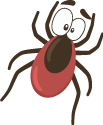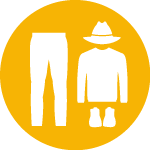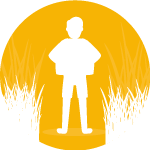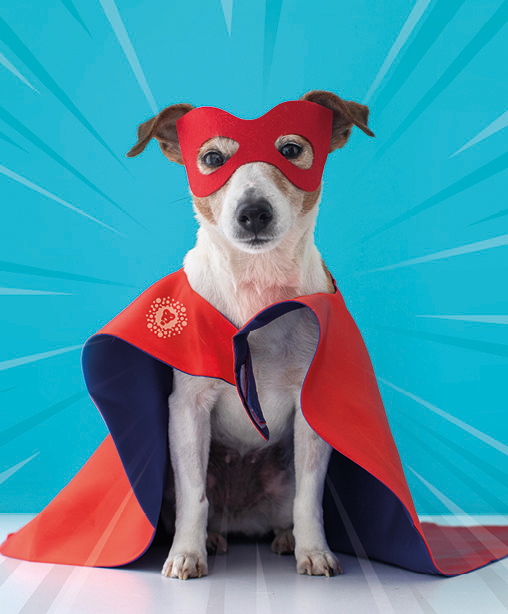« Avoid tick bites by adopting the right gestures and reflexes – just like our superheroes ! «
What type of bugs are ticks?
ID Description
 Class : arachnids
Class : arachnids
Subclass : acari (which includes mites)
Characteristics : their size can vary from less than 1 mm to 2.5 cm. They can live up to 7 years if weather conditions are favourable
Food : blood of mammals, birds, reptiles and amphibians
Habitat : forests, undergrowth, tall grasses and dead leaves. They are less common at high altitudes (+1800 m).
Ticks are arachnids that live in wooded, humid areas as well as in tall grass in meadows and forest parks. They are increasingly found in urban parks and gardens (in shrubs and dead leaves). The spread of ticks is in part due to global warming and biodiversity loss, especially between early spring and late autumn. Ticks attach themselves to an animal or human host to feed.
Do ticks really bite? Yes, ticks have curved teeth on their mouthparts that they use to cling to our skin. They bite us to feed on our blood. Although the bite itself is painless, ticks can transmit disease-causing microbes (e.g. bacteria, viruses, protozoa) that can lead to potentially serious infections such as Lyme disease or tick-borne encephalitis.
Ticks can be found at different stages of their development: as larvae (which are almost invisible to the naked eye), as nymphs (a few millimetres in length) and as adults.
Participate in the participatory research program
Recommendations, Tick Bite Treatment, and Information on Related Vector-borne Diseases
 √ Wear light-coloured clothing, so you can better spot any ticks on your body. Tuck the bottom of your trousers into your socks, or wear gaiters. Wear clothing designed to cover the body (e.g. head & neck protection, this especially goes for children) and closed shoes.
√ Wear light-coloured clothing, so you can better spot any ticks on your body. Tuck the bottom of your trousers into your socks, or wear gaiters. Wear clothing designed to cover the body (e.g. head & neck protection, this especially goes for children) and closed shoes.

√ Use a tick removal tool such as a tick twister or tick hook

√ Apply a suitable repellent to your clothing and skin.
For clothing, permethrin is often used. It can be applied to the outside of clothes, and remains effective for up to 6 weeks. Remember that repellents are potentially toxic and should therefore always be used and handled with care. Always read the product instructions and follow the precautions for use.
The use of repellents applied directly to the skin is also an option. Products containing the following active ingredients can be used: DEET, IR 3535, Picaridin and citriodiol (recommended by France’s National Authority for Health – or HAS).

√ Keep to the middle of the path, away from tall grass, dead leaves and shrubbery. For breaks or picnics, look for a stony or grass-free area.

√ Avoid lying or sitting directly on the ground as this can help limit exposure. Place a light-coloured cloth on the ground to sit or lie on.

√ Examine your whole body, especially those areas where the skin is thinnest, such as underarms, knee folds, genital areas, the navel, ear canals and scalp. This examination should best be performed as soon as possible. Ticks in the nymph or larval stage are difficult to spot, so the examination should be performed carefully by running your hand over your skin.
If you are bitten by a tick…
The tick should be removed as quickly as possible.

The tick is best removed mechanically using a tick twister or hook, pulling and rotating the tick perpendicular to the skin, making sure not to detach the head of the tick. Tick removal tools can be purchased in pharmacies. They come in small sizes designed for removing nymphs and in larger sizes for removing adult ticks.
The bite site should always be disinfected after removal (and not before, so as to limit the risk of the tick regurgitating).
It is best to consult a doctor in the following cases :
√ If redness persists or spreads at the site of the bite (or if a black spot appears)
√ If you show symptoms (e.g. pain, fever, unexplained tiredness, damage to skin, joints or the nervous system)
√ If you don’t manage to remove the tick.
Your doctor may prescribe a course of antibiotics, if deemed useful. The details of the tick bite (e.g. date and anatomical location) should preferably be noted in the patient’s file. Keep an eye on the bite site for at least one month.
What to do with the tick:

After removing the tick, do not throw it away! It may be useful. There is a participatory science programme designed to promote tick bite prevention, research projects and develop a tick bite database.
You can participate in this programme by sending your tick to the researchers: Place the tick inside a piece of absorbent paper then wrap the paper with sticky tape. This will prevent the tick from escaping or eating its way out of the paper. Be careful not to crush the tick. It is better to enclose it in a piece of absorbent paper, rather than taping it directly down onto paper, as doing so may make it unusable for the researchers.
To find out more about the programme, check out the website Citique at https://www.citique.fr/
To participate in the programme by helping to build up the tick bite database, please report any bites at: https://www.citique.fr/signalement-tique/
Even if you choose not to participate, don’t flush the tick down the toilet, as ticks can survive several days in water. It is essential to kill the tick, the most effective way being to burn it.
Vector-borne diseases, what are they?
Lyme Disease
Lyme disease is a bacterial infection transmitted when a host is bitten by a tick infected with Borrelia bacteria. It is a difficult disease to diagnose. The only specific symptom is migrant erythema which occurs in a few weeks following the bite. This is a red-coloured area that widens out to form the shape of a ring. However, it is not always visible. Other symptoms are variable and non-specific. They include headaches, fever, fatigue and sometimes joint and neurological damage (e.g. tingling and facial paralysis). This disease can become chronic and debilitating.
Lyme disease is not contagious.
Not all ticks are carriers of Borrelia bacteria. In France, the percentage of infected ticks varies from 0 to 20% depending on the region and season. Moreover, even when infected, a tick doesn’t always transmit the bacteria. Lastly, even if the bacteria is transmitted, the person bitten doesn’t necessarily develop the disease. Several studies conducted in Western Europe have shown that the probability of becoming ill after being bitten by a tick infected with Borrelia is about 6%. This means that over 90% of people bitten by infected ticks do not go on to develop the disease.
Tick-borne Encephalitis
Tick-borne encephalitis is caused by a virus (Flavivirus) which is also transmitted to humans via infested tick bites. Between 5,000 and 13,000 cases of tick-borne encephalitis are reported worldwide each year. Although cases of tick-borne encephalitis in France are still very rare, the disease is currently rampant between the 40th and 60th parallel from Europe to the north of Japan and China.
The epidemiological situation in France is still not very well known. About twenty cases are diagnosed each year, mainly in the regions of Alsace and Haute-Savoie or after being contracted abroad). These cases generally concern people conducting leisure activities in humid wooded areas (e.g. campers, hikers, mushroom pickers, and hunters.) In Europe, the most affected countries are the Czech Republic and Germany, as well as the Baltic countries. The disease is observed to be spreading towards Northern and Eastern Europe.
Symptoms and Treatment: After an incubation period of one to two weeks, symptoms of the disease appear abruptly. These include fever, headache and pain in muscles and joints. In 20-30% of patients, this is followed by symptoms due to damage to the central nervous system (e.g. encephalitis, myelitis) or to the peripheral nervous system (e.g. paresis or paralysis of a limb). There is no specific antiviral medication to treat this disease. Treatment is only symptomatic. Recovery from the disease is slow, with neurological or psychiatric effects that may persist for several years.











